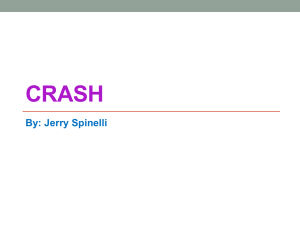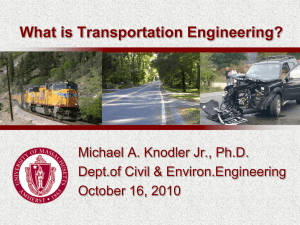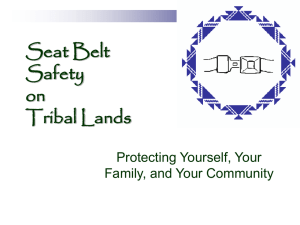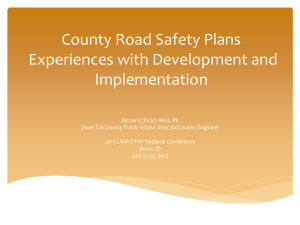Identification of High Crash Locations
advertisement
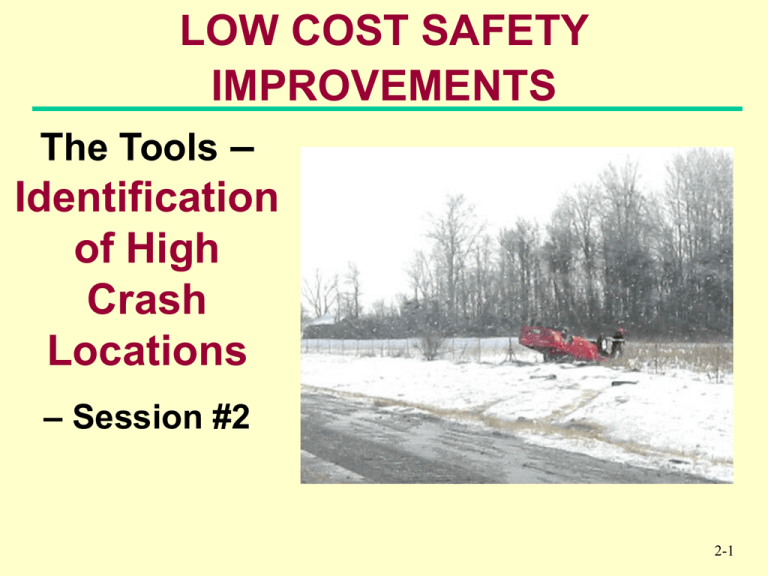
LOW COST SAFETY
IMPROVEMENTS
The Tools –
Identification
of High
Crash
Locations
– Session #2
2-1
Identification of High Crash Locations
Learning Outcomes:
1.
Identify appropriate Engineering
Countermeasures by using the 6 Step Crash
Mitigation Process
2-2
HSIP Planning
Network Screening or Site
Selection
List of
Sites for
Review
Detailed Engineering Study
Document
the
Analysis
Project Selection,
Implementation, & Evaluation
Document
the
Evaluation
2-3
Conventional Screening
Conventional techniques of screening use are
known to have difficulties in identifying ‘unsafe’
sites:
Crash counts = bias to high volume sites
Crash rates = bias to low volume sites
Crash rates’ assumption of linearity is invalid
Regression-to-mean (RTM) effect if sufficient
allowance is not made for random errors
2-4
What is Network Screening?
Highway network system
made up of segments
and intersections
Network screening is a
systematic examination
of all entities
Purpose: To rank all entities, based on
selected criteria, in order to conduct
detailed safety studies
http://www.ncdot.org//planning/statewide/gis/DataDist/CountyMap.html
Money should go where it achieves the greatest effect in terms
of preventing crashes and reducing their severity
2-5
PSI Index Approach
New and different approach to identify the
Potential for Safety Improvement (PSI)
Application of Safety Performance Functions
(SPFs) for each crash severity class for
different reference groups
PSI values for fatal, injury and PDO crashes
combined = PSI Index
Weights (relative cost) are applied to PSI
values
2-6
PSI Index Screening
PSIIndex is estimated for each location
Locations are ranked in descending
order of PSIIndex values
Locations with largest PSIIndex values
have most potential for crash reduction
2-7
SafetyAnalyst Tools
Network screening to identify sites with
promise for safety improvement
Diagnosis of safety concerns
Selection of countermeasures
Economic appraisal of countermeasures
Priority ranking of countermeasures
Evaluation of implemented projects
2-8
The six steps in the crash mitigation
process
1. Identify Sites
2. Collect Crash
Experience
3. Gather Field Conditions
4. Identify Contributing
Factors and
Countermeasures
5. Assess and Select
Countermeasures
6. Implement and
Evaluate
2-9
Step 1: Identify Sites with Potential
Safety Problems
Crash data
Traffic
Measures
Field
Observations
Complaints
Enforcement
input
Surrogate
measures
2-10
Step 1: Identify Sites with Potential
Safety Problems
Crash Information Methods:
Total Number of Crashes
Crash Density (Crashes per mile)
Crash Rate (Crashes per million vehicle miles)
Number Quality Control
Rate Quality Control
Crash Severity
Severity Index
Crash Index
2-11
Crash Rate Calculation
Roadway Segment:
CR = N / [ADT x 365 x L x 10-6]
where CR is expressed as “Crashes per million
vehicle miles (or kilometers)” and
N
= Number of crashes per year
ADT = Average Daily Traffic
L
= Length of segment (mi or km)
2-12
Crash Rate Calculation: Segment
Example:
For N = 50 crashes for 3 year period
ADT = 3,000 Average Daily Traffic
L = 2.8 miles
CR = N / [ADT x 365 x L x 10-6]
CR = 50 / [3,000 ADT x 3 yrs x 365 x 2.8
miles x 10-6]
CR = 5.43 crashes per million vehicle
miles
2-13
Average Crash Rates
Accident Rates and Costs by Road Type
Fatal
Injury
Property
Accidents Accidents
Damage
Only
Accidents
Location and Road Type
Number
Number
Number per
per MVM per MVM
MVM
Rural
No Access Control
2 lanes
0.07
0.94
1.39
4 or more lanes,
0.05
0.89
1.95
undiv.
Total
Accidents
Number per
MVM
2.39
2.89
Partial Access Control
Divided expressway
0.04
0.44
0.76
1.24
Freeway
0.03
0.27
0.49
0.79
2-14
Step 1: Identify Sites with
Potential Safety Problems
*From Mn DOT
Traffic Safety
Fundamentals
Handbook
2-15
Crash Rate Calculation
Intersection:
CR = N / {[Sum (ADT)s /2] x 365 x
10-6}
where CR is expressed as “crashes per million
entering vehicles” and
N = Number of crashes per year
Sum (ADT)s = Sum of all Average Daily Traffic
entering the intersection
2-16
Crash Rate Calculation: Intersection
Example: For N = 25 crashes for 3 years
ADT (N) = 10,000 ADT (S) = 9,000
ADT (E) = 3,500 ADT (W) = 4,000
Sum (ADT)s=(10,000+9,000+3,500+4,000)
= 26,500
CR = N / {[Sum (ADT)s /2] x 365 x 10-6}
CR = 25/ {26,500/2] x 3 yrs x365 x 10-6}
CR = 1.72 crashes per million entering
vehicles
2-17
Collision Types at Rural
Intersections
2-18
Average Intersection Crash Rates
• Average of 1.5 crashes per year for UnSignalized Intersections in rural areas–
recent California analysis*
• Average of 2.5 crashes per year in
urban areas
*NCHRP 500, Volume 5: A Guide for Addressing
Unsignalized Intersection Collisions, 2003.
2-19
Severity Index
Severity index (SI) is the ratio of crashes
involving an injury or fatality to total
crashes
2-20
Step 2: Characterize the Crash
Experience
Prepare a Collision Diagram
2-21
Non-Crash Based Procedures
ReferencesAppendix A:
2-22
Step 3: Characterize Field
Conditions
2-23
Step 3: Characterize Field
Conditions
2-24
Step 4: Identify Contributing Factors
and Appropriate Countermeasures
*See
Appendix for
Tables 12,
13, 14 and 15
2-25
Step 5: Assess Countermeasures and
Select Most Appropriate
Page 11-14 of Appendicies
See Appendix Tables
12, 13, & 14 for
“Contributing Factors”
Poor Delineation
2-26
Step 5: Assess Countermeasures and
Select Most Appropriate
go to Table of Crash Reduction Factors in the
Appendicies, page 11-22, Warning Signs, 3rd row
Warning Signs and Measures
Advance Warning Signs (General)
25%
Advance Curve Warning Signs
with Advisory Speed Plaques
22%
Advance Curve Warning Signs
without Advisory Speed Plaques
18%
Chevron Alignment Warning Signs
33% - 49%
2-27
Step 6: Implement Countermeasures
and Evaluate Effectiveness
Improve
Delineation
- Advance
Warning
Sign for
Curve with
Advisory
Speed
Plaque
CRF = 22%
2-28
Step 3: Characterize Field
Conditions
Traffic Data Studies:
Traffic Volume – Turning Movement, ADT
Spot Speeds
Traffic Conflict Study
Sight Distance Evaluation
2-29
Traffic Crash Costs:
AIS Level
Severity
Descriptor
Property Damage Only
Cost Per Injury
(Dollars)
65,000
AIS 3
Serious Injury
175,000
AIS 4
Severe
565,000
AIS 5
Critical
2,290,000
AIS 6
Fatal
3,000,000
2-30
Identification of High Crash
Locations – Exercise III
Discussion
For the
Countermeasure
Advance Curve
Warning Signs +
Advisory Speed
Plaque = 22%;
Calculate the benefit
$$ for “before period”
of 7 crashes
2-31
Introduction – Exercise III
Discussion
For the Countermeasure Advance
Curve Warning Signs + Advisory
Speed Plaque = 22%
Benefit for “Before Period of 7 Crashes
= 7 crashes x CRF of 22%
= 7 x 0.22 = 1.54 crashes reduced
Severity distribution = 0.32 (Inj+Fatal) + 0.68 Pdo
Benefit = (1.54 x 0.32 x $565,000) + (1.54 x 0.68
x $65,000) = $345,100
2-32
Identification of High Crash Locations
Appendix H:
Typical
Benefit/Cost
Ratios
* From MN
DOT Traffic
Safety
Fundamentals
Handbook
2-33
Identification of High Crash Locations
Review Questions:
What are the six
steps in the
crash mitigation
process?
2-34
Review: What are the six steps in the
crash mitigation process?
1. Identify Sites
2. Collect Crash
Experience
3. Gather Field Conditions
4. Identify Contributing
Factors and
Countermeasures
5. Assess and Select
Countermeasures
6. Implement and
Evaluate
2-35
Identification of High Crash Locations
Review Questions:
What low cost
safety measure
has the highest
benefit to cost
ratio?
Lighting CRF = 50+%
2-36
Identification of High Crash Locations
Learning Outcomes:
1.
Identify appropriate Engineering
Countermeasures by using the 6 Step Crash
Mitigation Process
2-37
Identification of High Crash Locations
Questions?
2-38


